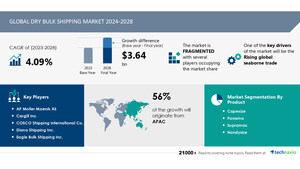NEW YORK, May 31, 2024 /PRNewswire/ -- The global textile manufacturing market size is estimated to grow by USD 346.05 billion from 2024-2028, according to Technavio. The market is estimated to grow at a CAGR of 4.52% during the forecast period.
For more insights on the forecast market size and historic data (2018 - 2022) - Download Free sample report in minutes
Forecast period |
2024-2028 |
Base Year |
2023 |
Historic Data |
2018 - 2022 |
Segment Covered |
Type (Natural fibers, Polyesters, Nylons, and |
Region Covered |
APAC, North America, Europe, South America, and |
Key companies profiled |
Aditya Birla Management Corp. Pvt. Ltd., |
Key Market Trends Fueling Growth
Textile manufacturing market experiences growth due to automation in processes. Automated machinery improves quality and efficiency in fiber manufacturing, yarn manufacturing, weaving, and dyeing. Fiber diameter monitoring and temperature control are critical in fiber manufacturing, while homogeneous cotton mixing and yarn fault detection enhance yarn quality.
Weaving machines use CAD and AI for precision production. Automated dyeing optimizes the dyeing process, reducing labor costs and manual handling, resulting in superior-textile products. Overall, automation's integration into textile manufacturing significantly benefits the industry.
The textile manufacturing market is experiencing significant trends with the use of various technologies. Polyesters, silks, wools, linens, rayons, acrylics, nylons, and technics are popular textile materials. Producers are focusing on consumption and production of these textiles. Sustainability is a key factor, with manufacturers adopting manufacturing practices that reduce waste and improve efficiency.
Fabricating units are implementing modern technology like automation and digitization to enhance productivity. Traditional methods like spinning and weaving are being combined with new techniques for superior textile quality. Finishing processes are also being improved to create textiles with enhanced durability and comfort. Overall, the textile manufacturing industry is evolving to meet changing consumer demands and market trends.
Market Challenges
- The textile manufacturing market experiences challenges due to the high upfront costs of acquiring modern machinery, particularly for small and medium-sized enterprises (SMEs). This financial barrier hinders SMEs from adopting advanced technology, giving larger firms an edge. Expensive investments in computerized knitting machines, automated looms, and digital printing equipment limit SMEs' competitiveness, potentially slowing industry progress towards technological innovation.
- Potential solutions include financing options, government incentives, and industry collaborations to encourage SME adoption of sophisticated textile machinery. This significant initial investment may negatively impact the growth of the global textile manufacturing market during the forecast period.
- The textile manufacturing market faces several challenges in production, technology, and sourcing. Producers struggle with maintaining profitability due to increasing costs of raw materials like cotton and synthetic fibers. Silk, wool, and linen are traditional textiles with high demand but production costs are high. Consumption patterns also impact the industry, with trends towards sustainability and ethical production.
- Traditional manufacturing processes are being replaced by modern technology like Rayon and Acrylic production. The need for non-novel textiles like Consumption and Producion is increasing. Trade and Denim are significant markets, but competition is fierce. Finishing and Fashion are crucial factors, requiring continuous innovation. Overall, the textile industry must adapt to changing consumer preferences and technological advancements to remain competitive.
Research report provides comprehensive data on impact of trend, driver and challenges - Download Free sample report in minutes
Segment Overview
- Type
- 1.1 Natural fibers
- 1.2 Polyesters
- 1.3 Nylons
- 1.4 Others
- Application
- 2.1 Fashion
- 2.2 Technical
- 2.3 Household
- 2.4 Others
- Geography
- 3.1 APAC
- 3.2 North America
- 3.3 Europe
- 3.4 South America
- 3.5 Middle East and Africa
1.1 Natural fibers- The textile manufacturing market is driven by the extensive use of natural fibers in various industries. Major natural fibers include cotton, wool, silk, hemp, and jute, sourced from plant and animal sources. Mexico is a significant producer of these fibers, with high expected production and exports of cotton. The use of natural fibers in clothing, construction materials, medical dressings, and automotive interiors contributes to market growth. Wool's flexibility, insulation, and thermal stability, and silk's quick-drying nature, durability, and softness add value to the market. Cotton's versatility in textiles and industrial applications further boosts growth.
For more information on market segmentation with geographical analysis including forecast (2024-2028) and historic data (2018 - 2022) - Download a Sample Report
Research Analysis
The textile manufacturing market encompasses various processes including the production of Fabric from Fiber through Spinning, Weaving, Knitting, and Finishing. The resulting textiles are then transformed into Apparel and Garments using techniques such as Dyeing, Printing, and Sustainability-focused innovations.
The industry caters to diverse materials like Cotton, Polyester, Silk, Wool, Linen, Rayon, Acrylic, Nylon, Technical textiles, Nonwovens, and Denim. Textile technology and Textile trends continually evolve, driving advancements in areas like Sustainability, Textile innovation, and Technical textiles for various industries.
Market Research Overview
The Textile Manufacturing Market encompasses the production of fibers, yarns, fabrics, and finished textile products using various processes such as spinning, weaving, knitting, dyeing, finishing, and printing. This industry is significant due to its vast application in various sectors including apparel, home furnishings, industrial, and automotive. The market is driven by factors such as increasing consumer demand for textiles, technological advancements, and growing global trade.
Additionally, the industry faces challenges such as rising raw material costs, increasing competition, and changing consumer preferences. The market is segmented based on fiber types, manufacturing processes, and end-use industries. The future of the textile manufacturing market looks promising with the ongoing trend towards sustainable and eco-friendly textiles and the increasing adoption of automation and digitalization in the industry.
Table of Contents:
1 Executive Summary
2 Market Landscape
3 Market Sizing
4 Historic Market Size
5 Five Forces Analysis
6 Market Segmentation
- Type
- Natural Fibers
- Polyesters
- Nylons
- Others
- Application
- Fashion
- Technical
- Household
- Others
- Geography
- APAC
- North America
- Europe
- South America
- Middle East And Africa
7 Customer Landscape
8 Geographic Landscape
9 Drivers, Challenges, and Trends
10 Company Landscape
11 Company Analysis
12 Appendix
About Technavio
Technavio is a leading global technology research and advisory company. Their research and analysis focuses on emerging market trends and provides actionable insights to help businesses identify market opportunities and develop effective strategies to optimize their market positions.
With over 500 specialized analysts, Technavio's report library consists of more than 17,000 reports and counting, covering 800 technologies, spanning across 50 countries. Their client base consists of enterprises of all sizes, including more than 100 Fortune 500 companies. This growing client base relies on Technavio's comprehensive coverage, extensive research, and actionable market insights to identify opportunities in existing and potential markets and assess their competitive positions within changing market scenarios.
Contacts
Technavio Research
Jesse Maida
Media & Marketing Executive
US: +1 844 364 1100
UK: +44 203 893 3200
Email: [email protected]
Website: www.technavio.com/
SOURCE Technavio

WANT YOUR COMPANY'S NEWS FEATURED ON PRNEWSWIRE.COM?
Newsrooms &
Influencers
Digital Media
Outlets
Journalists
Opted In





Share this article